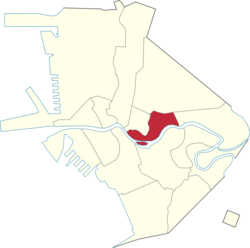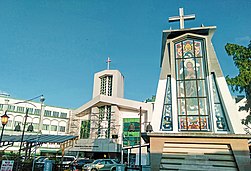San Miguel | |
|---|---|
District of Manila | |
 | |
 | |
 | |
| Country | Philippines |
| Region | National Capital Region |
| City | Manila |
| Congressional district | 6th District |
| Barangays | 12 |
| Area | |
| • Total | 0.9137 km2 (0.3528 sq mi) |
| Population (2020)[1] | |
| • Total | 18,599 |
| • Density | 20,000/km2 (53,000/sq mi) |
| Time zone | UTC+08:00 (Philippine Standard Time) |
| ZIP code | 1005 |
| Area codes | 02 |
San Miguel (Tagalog pronunciation: [sɐn miˈgɛl]) is a primarily middle-class residential area of the City of Manila and is one of the city's sixteen traditional districts.
Background
[edit]Much of San Miguel is located on a riverine island, separated by the mainland by the Estero de (Stream of) San Miguel, and by the Pasig River. In order to reach the district, one has to cross any of the following bridges traversing Estero de San Miguel, from west to east: Carlos Palanca Bridge, P. Casal Bridge, Nepomunceno Bridge, Arlegui Bridge, San Rafael Bridge, Chino Roces Bridge (carrying Mendiola Street), Concepcion Aguila Bridge and J.P. Laurel Bridge. P. Casal Bridge's logical extension is the Ayala Bridge, that connects it to the southern bank of the Pasig.
On the district's eastern parts is another riverine island, bounded by the Estero de San Miguel and Estero de Sampaloc. A small part is on the mainland, at the far eastern corner.
San Miguel also includes the Isla de Convalecencia, the largest island in the Pasig River, which is home to the Hospício de San José, Manila's oldest Catholic welfare institution.
Malacañang Palace, the seat of the Government of the Philippines and official residence of the President of the Philippines, is located in the neighborhood, and outside the Palace gates is Mendiola Street, a popular site for protests against the government.
The San Miguel district is also home to some colleges and universities that form part of Manila's "University Belt" which encompasses San Miguel, and the districts of Quiapo and Sampaloc. Educational institutions that are located in the district include Far Eastern University, San Beda University, Centro Escolar University, College of the Holy Spirit, Saint Jude Catholic School, La Consolacion College Manila and Victorino Mapa High School.
San Miguel is also the place where San Miguel Beer was originally produced, beginning in the Spanish colonial era. The brewery's buildings were demolished after the property was transferred to the Philippine government, and it today forms part of the Palace complex.
Barangays
[edit]

San Miguel is divided into 12 barangays, grouped in three zones of the City of Manila. Barangays 637 to 640 are part of Zone 65, while Barangays 641 to 644 are part of Zone 66 and Barangays 645 to 648 are part of Zone 67.
- Barangays of San Miguel
| Zone/Barangay | Land area (km²) | Population (2020) |
|---|---|---|
| Zone 65 | ||
| Barangay 637 | 0.03124 km² | 1,295 |
| Barangay 638 | 0.1254 km² | 545 |
| Barangay 639 | 0.03027 km² | 490 |
| Barangay 640 | 0.1055 km² | 2,145 |
| Zone 66 | ||
| Barangay 641 | 0.08799 km² | 763 |
| Barangay 642 | 0.05602 km² | 1,279 |
| Barangay 643 | 0.1319 km² | 657 |
| Barangay 644 | 0.02500 km² | 729 |
| Zone 67 | ||
| Barangay 645 | 0.08413 km² | 1,704 |
| Barangay 646 | 0.06953 km² | 918 |
| Barangay 647 | 0.1157 km² | 2,440 |
| Barangay 648 | 0.04226 km² | 5,634 |
Attractions
[edit]Casa Roces
[edit]Casa Roces is a 1930s ancestral house of the Roces family which was renovated and turned into a full-service restaurant, café and an art gallery. Casa Roces is located in the district of San Miguel, Manila right across Malacañan Palace, the official residence of the President of the Republic of the Philippines. The ground floor of Casa Roces features a coffeehouse with an outdoor wooden deck, a dessert bar, and a memorabilia and accessories shop. A bar also serves cocktails, wine, beer and liquor for evening patrons. On the second floor are a bistro, an art and family heritage gallery as well as private rooms decorated with a mix of Commonwealth elegance and modern flair. The second floor of the house was turned into a multi-purpose dining venue and an art gallery.
Casa Roces was designed in the Pre-war modernist style with Art Deco articulation using a variety of construction materials which includes reinforced concrete, wood and masonry. On the ground floor, the distinguishing feature is the use of "Machuca" tile flooring which is typical with Commonwealth era house. The original layout of the rooms were changed to accommodate its new use as a restaurant and an art gallery.
Notable people
[edit]References
[edit]- ^ Final Results - 2007 Census of Population Archived July 16, 2012, at the Wayback Machine
| Topics |  | |
|---|---|---|
| Government | ||
| Districts | ||
| Mixed-use developments | ||
| Beaches | ||
| Legislative districts | ||